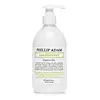What's inside
What's inside
 Key Ingredients
Key Ingredients

No key ingredients
 Benefits
Benefits

 Concerns
Concerns

 Ingredients Side-by-side
Ingredients Side-by-side

Water
Skin ConditioningBrassica Alcohol
EmollientBrassicamidopropyl Dimethylamine
Skin ConditioningAspartic Acid
MaskingCaprylhydroxamic Acid
Caprylyl Glycol
EmollientGlycerin
HumectantCetearyl Alcohol
EmollientPolysorbate 60
EmulsifyingVinegar
Lactic Acid
BufferingHydrolyzed Pea Protein
EmollientChamomilla Recutita Extract
Skin ConditioningMelissa Officinalis Leaf Extract
Skin ConditioningRosmarinus Officinalis Leaf Extract
AntimicrobialWater, Brassica Alcohol, Brassicamidopropyl Dimethylamine, Aspartic Acid, Caprylhydroxamic Acid, Caprylyl Glycol, Glycerin, Cetearyl Alcohol, Polysorbate 60, Vinegar, Lactic Acid, Hydrolyzed Pea Protein, Chamomilla Recutita Extract, Melissa Officinalis Leaf Extract, Rosmarinus Officinalis Leaf Extract
Water
Skin ConditioningEthylhexyl Palmitate
EmollientGlycerin
HumectantBetaine
HumectantCaprylic/Capric Triglyceride
MaskingDicaprylyl Carbonate
EmollientInulin
Skin ConditioningHydroxyethylcellulose
Emulsion StabilisingLauryl Glucoside
CleansingPolyglyceryl-2 Dipolyhydroxystearate
Skin ConditioningBiotin
AntiseborrhoeicCetrimonium Chloride
AntimicrobialCitric Acid
BufferingParfum
MaskingHydrolyzed Wheat Protein
Skin ConditioningPanthenol
Skin ConditioningPantolactone
HumectantPhenoxyethanol
PreservativePolyquaternium-37
Pyridoxine Hcl
Skin ConditioningSclerotium Gum
Emulsion StabilisingSodium Benzoate
MaskingTocopherol
AntioxidantTocopheryl Nicotinate
AntioxidantCI 19140
Cosmetic ColorantCI 15985
Cosmetic ColorantWater, Ethylhexyl Palmitate, Glycerin, Betaine, Caprylic/Capric Triglyceride, Dicaprylyl Carbonate, Inulin, Hydroxyethylcellulose, Lauryl Glucoside, Polyglyceryl-2 Dipolyhydroxystearate, Biotin, Cetrimonium Chloride, Citric Acid, Parfum, Hydrolyzed Wheat Protein, Panthenol, Pantolactone, Phenoxyethanol, Polyquaternium-37, Pyridoxine Hcl, Sclerotium Gum, Sodium Benzoate, Tocopherol, Tocopheryl Nicotinate, CI 19140, CI 15985
 Reviews
Reviews

Ingredients Explained
These ingredients are found in both products.
Ingredients higher up in an ingredient list are typically present in a larger amount.
Glycerin is already naturally found in your skin. It helps moisturize and protect your skin.
A study from 2016 found glycerin to be more effective as a humectant than AHAs and hyaluronic acid.
As a humectant, it helps the skin stay hydrated by pulling moisture to your skin. The low molecular weight of glycerin allows it to pull moisture into the deeper layers of your skin.
Hydrated skin improves your skin barrier; Your skin barrier helps protect against irritants and bacteria.
Glycerin has also been found to have antimicrobial and antiviral properties. Due to these properties, glycerin is often used in wound and burn treatments.
In cosmetics, glycerin is usually derived from plants such as soybean or palm. However, it can also be sourced from animals, such as tallow or animal fat.
This ingredient is organic, colorless, odorless, and non-toxic.
Glycerin is the name for this ingredient in American English. British English uses Glycerol/Glycerine.
Learn more about GlycerinWater. It's the most common cosmetic ingredient of all. You'll usually see it at the top of ingredient lists, meaning that it makes up the largest part of the product.
So why is it so popular? Water most often acts as a solvent - this means that it helps dissolve other ingredients into the formulation.
You'll also recognize water as that liquid we all need to stay alive. If you see this, drink a glass of water. Stay hydrated!
Learn more about Water